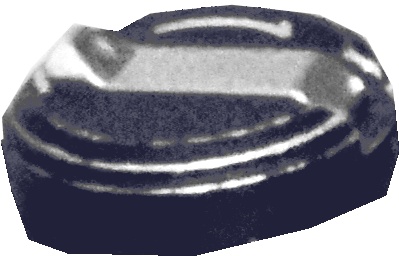











The Nikon FE uses a battery to power auto exposure. The auto exposure mode uses an aperture-priority system which means that the user can set the aperture on their lens and have control of the depth of field while the FE automatically adjust's its shutter speed to get the "correct" exposure (correct exposure is subjective). Having auto exposure allows the FE to be more accessible to beginners who might not be experienced in shooting manually and to anyone who wants to quickly and easily take photographs.
Shutter Speed Ring
The Nikon FE is a 35mm SLR. SLR stands for single-lens reflex and allows photographers to view the exact composition of the image before shooting. These cameras use a mirror and optical glass to show the potential image in the viewfinder. Once the shutter button is released, the mirror lifts so the light can reach the film and chemically react. The film gets darker in areas light touched for black and white. For color, there's different layers for the primary colors of light: red, green and blue. At the same time, the shutter opens for the length of time determined by the shutter speed. Aperture controls how much light is allowed in during that time.
Main Reflex Mirror
Something that really stands out about the Nikon FE as a compact SLR is its lens compatibility. The Nikon FE accepts every Nikon F-mount lens made since 1959. This includes Nikon's earlier non-AI lenses. Other comparable cameras, such as its predecessor the FE2, don't have the same capability. Non-AI lenses can open the door for added experimentation with film photography.
Nikon 50mm f/1.8 Series E
During the 70s, the market for SLR cameras shifted to focus on beginners and hobbyists with the introduction of cameras that were more compact. The releases of Nikon's competitors proved how lucrative portable cameras were to the market outside of professionals. To compete, Nikon produced the FM, the first of six small, beginner to mid-range SLRs. Soon after followed the FE in 1978 and it was manufactured until 1983.
Rewind Film Knob & Crank
The film advance lever has dual purposes. It's used to advance to the next exposure on the roll of film and to turn the camera on and off. The camera also has a battery check light, a small detail that similar Nikons of its time failed to include. Despite having electronic components, the FE is fully functional mechanically. Both the M90 and bulb shutter speed settings are mechanical and can be used without any battery. This duality allows the photographer to have more flexibility and prevents being stopped by a drained battery. Next to the film advance lever is a small multiple exposure lever that makes double exposures easy to achieve.
Film Advance Lever